The NVIDIA GeForce GTX 1660 Ti Review, Feat. EVGA XC GAMING: Turing Sheds RTX for the Mainstream Market
by Ryan Smith & Nate Oh on February 22, 2019 9:00 AM ESTCompute & Synthetics
Shifting gears, we'll look at the compute and synthetic aspects of the GTX 1660 Ti.
Beginning with CompuBench 2.0, the latest iteration of Kishonti's GPU compute benchmark suite offers a wide array of different practical compute workloads, and we’ve decided to focus on level set segmentation, optical flow modeling, and N-Body physics simulations.

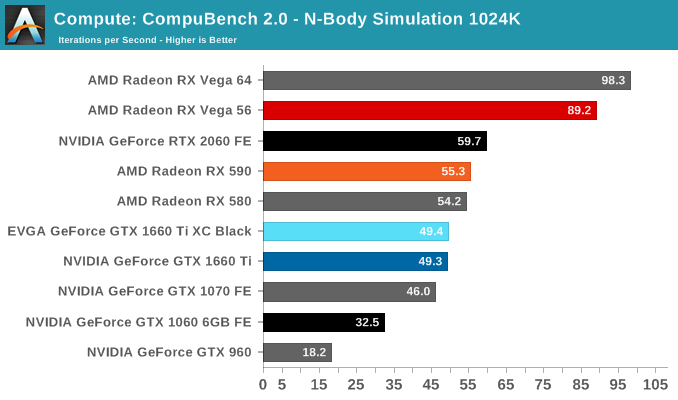
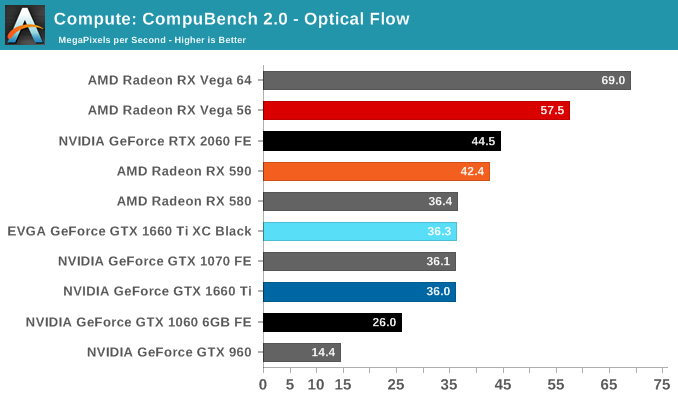
On paper, the GTX 1660 Ti looks to provide around 85% of the RTX 2060's compute and shading throughput; for Compubench, we see it achieving around 82% of the latter's performance.
Moving on, we'll also look at single precision floating point performance with FAHBench, the official Folding @ Home benchmark. Folding @ Home is the popular Stanford-backed research and distributed computing initiative that has work distributed to millions of volunteer computers over the internet, each of which is responsible for a tiny slice of a protein folding simulation. FAHBench can test both single precision and double precision floating point performance, with single precision being the most useful metric for most consumer cards due to their low double precision performance.
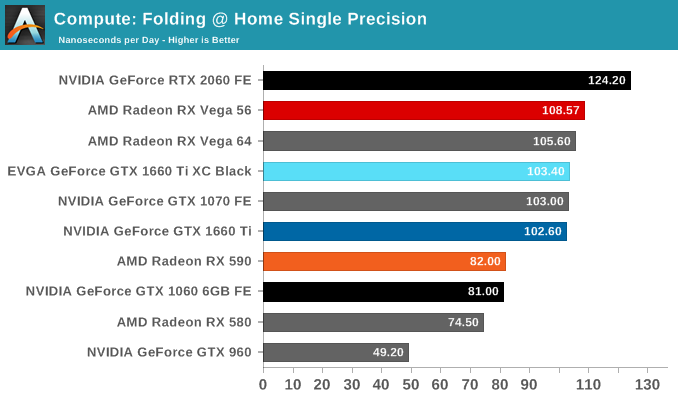
Next is Geekbench 4's GPU compute suite. A multi-faceted test suite, Geekbench 4 runs seven different GPU sub-tests, ranging from face detection to FFTs, and then averages out their scores via their geometric mean. As a result Geekbench 4 isn't testing any one workload, but rather is an average of many different basic workloads.
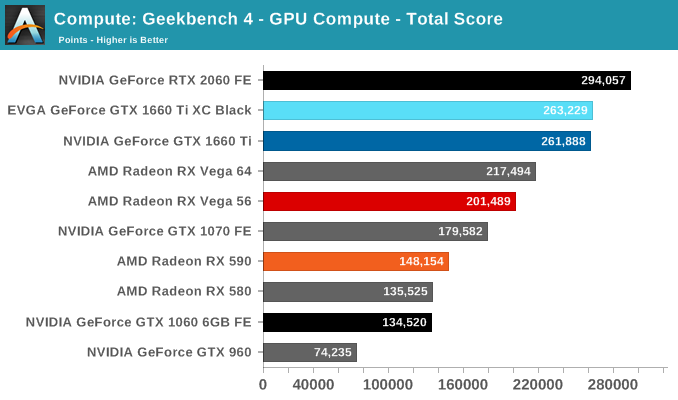
In lieu of Blender, which has yet to officially release a stable version with CUDA 10 support, we have the LuxRender-based LuxMark (OpenCL) and V-Ray (OpenCL and CUDA).
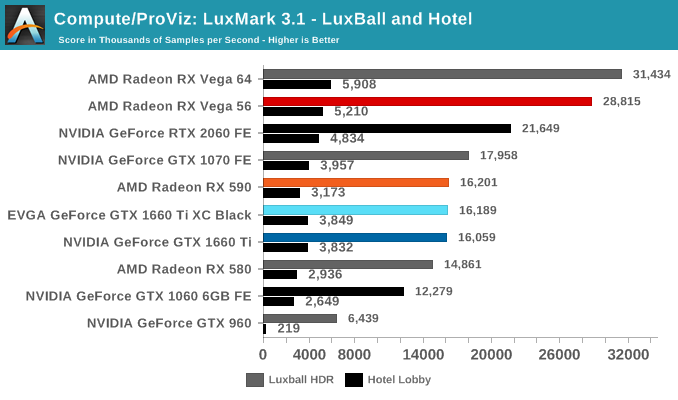
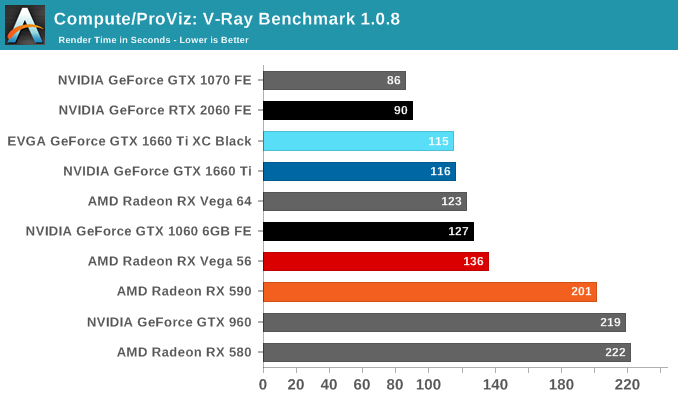
We'll also take a quick look at tessellation performance.
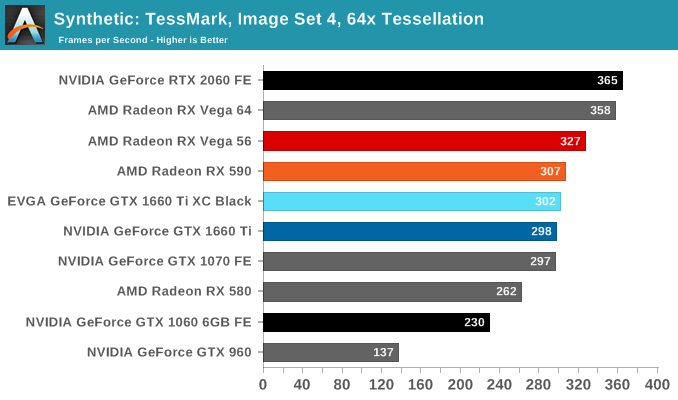
Finally, for looking at texel and pixel fillrate, we have the Beyond3D Test Suite. This test offers a slew of additional tests – many of which we use behind the scenes or in our earlier architectural analysis – but for now we’ll stick to simple pixel and texel fillrates.
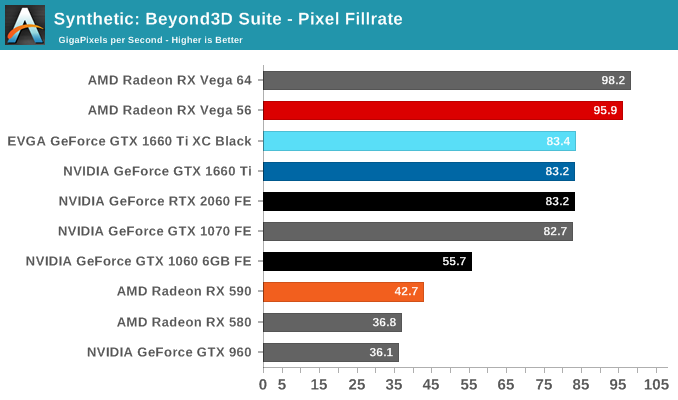
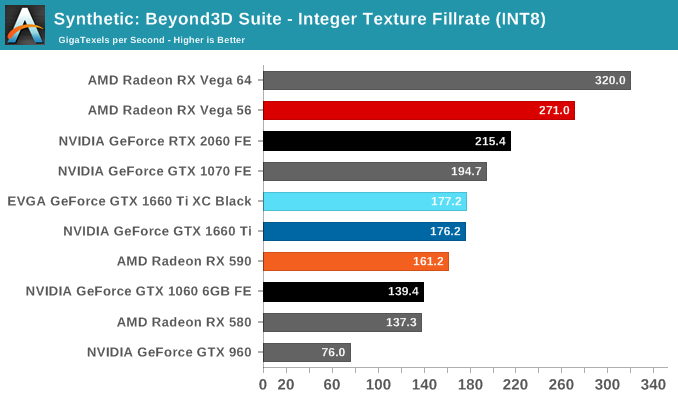
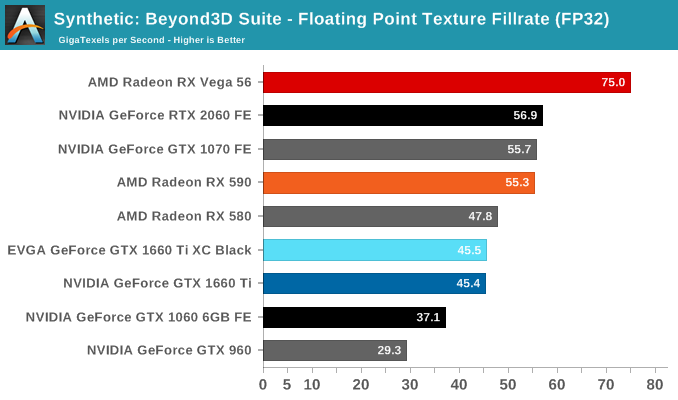
The practically identical pixel fill rates for the GTX 1660 Ti and RTX 2060 might seem odd at first blush, but it is an entirely expected result as both GPUs have the same number of ROPs, similar clockspeeds, same GPC/TPC setup, and similar memory configurations. And being the same generation/architecture, there aren't any changes or improvements to DCC. In the same vein, the RTX 2060 puts up a 25% higher texture fillrate over the GTX 1660 Ti as a consequence of having 25% more TMUs (96 vs 120).










157 Comments
View All Comments
Korguz - Tuesday, March 5, 2019 - link
and again.. WHERE do you get your info from ??they can remove parts of IC's, or disable them, have you not been reading the articles on here about the disabled IGPs in intels cpus, but still charging the SAME price as the fully enabled ones ?
you refuse post links, OR mention your sources, simply because YOU DONT HAVE ANY.. IMO.. most of what you most.. is probable made up, or rumor, if AT posted things like you do, with no sources, you probably would be all over them asking for links, proof and the like... and by YOUR previous posts, all of your info is made up and false..
there is no point talking to a CHILD any more... when are you going to resort to name calling and insults again ?
Hrel - Friday, March 1, 2019 - link
Last page, I don't think comparing the 1660ti to the 1060 6Gb is appropriate, either the 3GB or 1050Ti. Comparing it to the 1060 makes it look like Nivdia isn't raising prices as much as they really are.I'm basically out of the GPU market unless and until pricing changes. Not that any good games have come out in the last few years, or are scheduled to. But I should be able to run 3 monitors at 1080p with 60fps minimum in any modern game for $200. Based on the numbers here, I don't think this $300 1660Ti could even do that, and we're already over the threshold by $100.
You are right about not caring about RTX. Basically the timing was just really bad for it, global economy is in contraction. Moore's law is dead, I guess that's why they're trying some other form of value add, but charging consumers isn't the way to do it. Labor participation rate is barely above 60%, over 1/3rd of the country is unemployed. Wages have stagnated for 70 years! We don't have any more to give!
crazyforsurprise - Wednesday, March 6, 2019 - link
<a href="https://www.crazyforsurprise.com/nvidia-gtx-1660-t... review </a>Questor - Wednesday, March 6, 2019 - link
Does anyone think EVGA could add just a bit more depth to that card? What is it? A 3 slot? At least 2.5. It's either a portable furnace or idiotic overkill.zazzn - Friday, April 19, 2019 - link
Why is PUBG never tested as one of the test games? It's notoriously badly optimized showing true raw performance?rothayato - Monday, August 5, 2019 - link
As a SFFPC (mITX) user, I'm enjoying the thicker, but shorter, card as it makes for easier packaging.Additionally, I'm enjoying the performance of a 1070 at reduced power consumption (20-30w) and therefore noise and heat! https://rottenhayato.com/_udata/gsnn/tenor-369.gif
bobhumplick - Tuesday, August 20, 2019 - link
if somebody hasnt upgraded in a while (9 series or older or 300 series or older for amd) then one of these cards is ok. not great but adequate. if you can last with what you have or if you would be happy with used or a refurb then go that route or wait for real nextgen(zotac has refurbed 1070 tis for 269 and they overclock to 1080 level performance).nvidia wanted to put these on 7nm or at least 10nm. 10nm isnt worth it in terms of performance and density (its more of a cell phone node) and 7nm needs EUV ot make large dies. its the waiting game. once EUV comes (if it does) the we will see a spurt of card gens coming quicker like they used to and then another slow down after about 5nm maybe